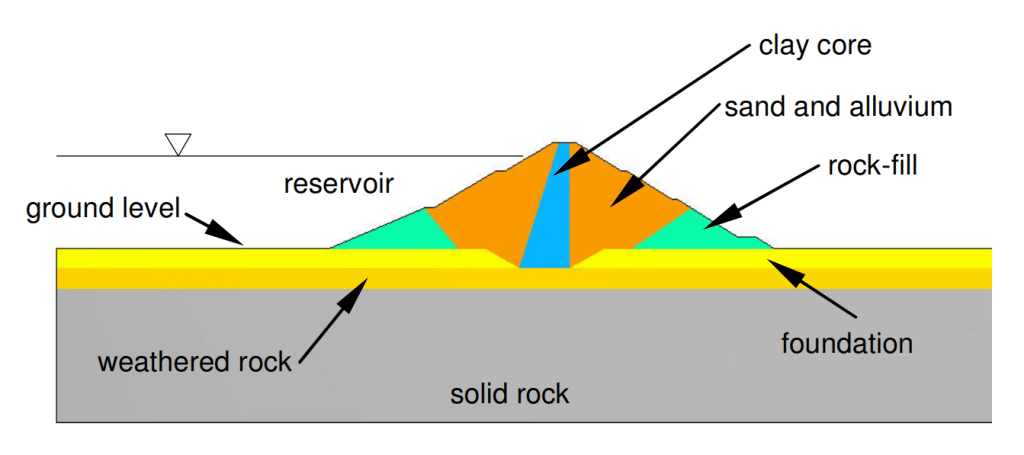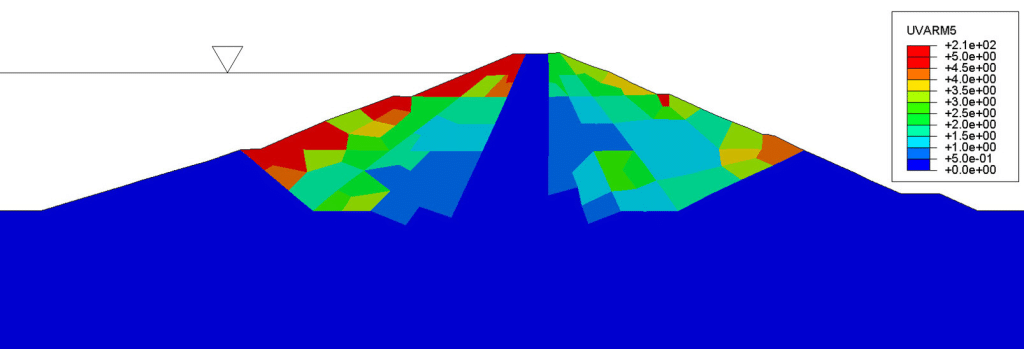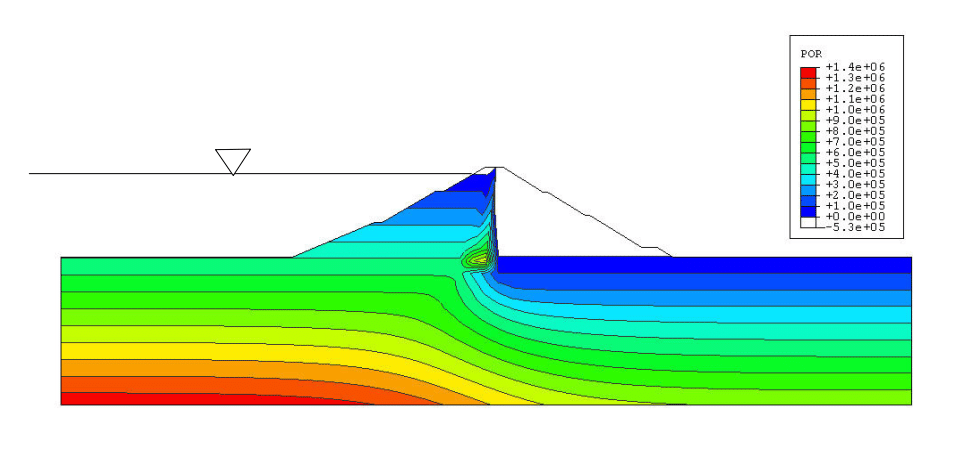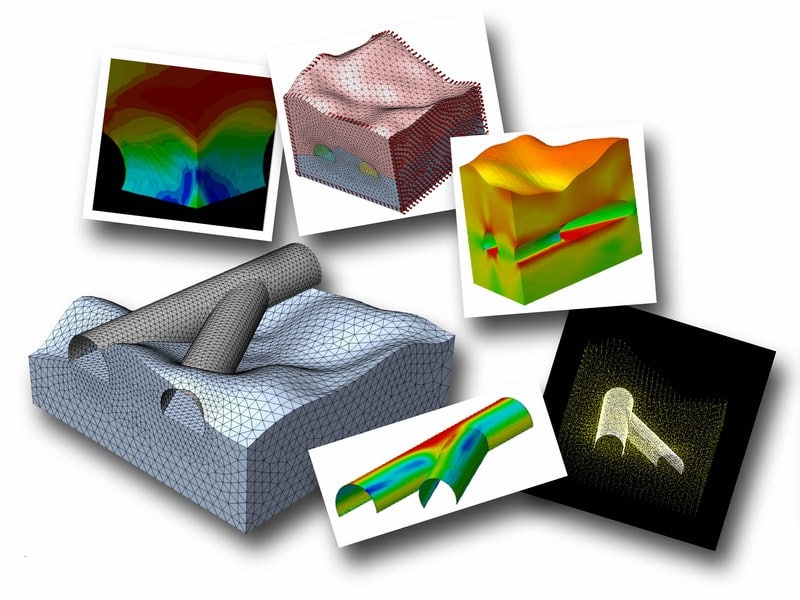Finite Element Simulation of Dam: Seismic Design, Thermal Analysis, Fluid Structure Interaction for Hydrodynamics Effects Assessment
FEA & CFD Based Simulation Design Analysis Virtual prototyping MultiObjective Optimization
Analysis of Dams is one of the specialties that need extensive experience of using material models and analysis capabilities that must be include phased (staged) construction, soil-structure and fluid-structure interaction, user supplied material models, large range of interface models, large displacement and large strain analyses, material non-linearity, time and ambient dependency effects, and nonlinear dynamic analysis.
Constitutive Material models used for Soil-Rock-Dam FEA Simulation
- Mohr-Coulomb and Drucker-Prager
- Tresca and Von Mises
- Modified Mohr-Coulomb (double-hardening)
- Hoek-Brown and Jointed-rock
- Modified Cam-Clay
- Jardine (London Clay)
- Nonlinear elasticity (Duncan-Chang)
- Smeared crack models with fixed and rotating cracks
- Material aging
- Liquefaction
- Mohr-Coulomb and Drucker-Prager
- Viscoelasticity
- Shrinkage
- Linear elastic and plastic reinforcements
- User-supplied materials

Finite Element Simulation of Seismic Behavior of Dam including Soil-Rock-Dam Interaction
Enteknograte engineers participate in method development, advanced simulation work, software training and support. Over experiences in engineering consulting and design development enables Enteknograte’s engineering team to display strong/enormous client focus and engineering experience.



Finite Element Simulation of Soil-Rock-Dam Interaction
Dynamic Analysis of Dams Include:
- Direct frequency analysis, modal response analysis, and spectral response analysis, with fluid-structure interaction
- Linear and nonlinear time domain analysis with a wide choice of time integration schemes
- Hybrid frequency-time domain analysis, with possibility to include compressibility of the fluid and bottom absorption
- Multi-directional acceleration loads
- Viscous, structural and continuous damping
- Specified or calculated initial conditions
- Fully coupled consolidation
- Saturated and partially saturated soils
- Steady-state and transient ground-water flow
- Drained/undrained soil
- Phased analysis
- Nonlinear analysis
- Coupled thermo-stress analysis
- Young hardening concrete behavior also with cooling
- Time, temperature and maturity dependency
- Discrete and smeared crack analysis
Enteknograte offers a Virtual Engineering approach with CFD and FEA tools such as MSC Cradle, Ansys Fluent, StarCCM+ for flows simulation and FEA based Codes such as ABAQUS, Ansys, Nastran and LS-Dyna, encompassing the accurate prediction of in-service loads, the performance evaluation, and the integrity assessment including the influence of manufacturing the components. Dependent of problem, we use ESI VA-one and MSC Actran as acoustics solver

Most common types of dams:
Gravity Dams: These dams rely on their own weight to resist the horizontal forces exerted by the water. Gravity dams are usually constructed using concrete or masonry and are commonly used for large-scale projects. The Grand Coulee Dam in Washington is an example of a gravity dam.
Arch Dams: Arch dams are curved structures that transfer the water’s force to the abutments or sides of a valley. They are constructed using materials like concrete and are particularly suitable for narrow canyons or gorges. The Hoover Dam is an example of a combined gravity and arch dam on the border between the U.S. states of Nevada and Arizona.
Embankment Dams: Also known as earthfill dams, these dams are constructed using compacted earth, rock, or other locally available materials. They are built in places where there is an abundant supply of suitable fill material. The Aswan High Dam in Egypt is an example of an embankment dam.
Concrete-Faced Rockfill Dams (CFRD): CFRD dams combine the principles of both concrete and embankment dams. They consist of a rockfill core with a concrete face or slab on the upstream side to prevent water leakage. This type of dam is often used when suitable foundation rock is available, and the concrete facing provides a watertight barrier. The Jiangpinghe Dam in Chine is an example of a concrete-faced rockfill dam.
Buttress Dams: Buttress dams consist of a series of triangular-shaped buttresses or supports on the downstream side, which transmit the water’s force to the foundation. The space between the buttresses is usually filled with compacted material. The Daniel-Johnson Dam in Canada is an example of a multiple-arch buttress dam.
Arch-Gravity Dams: These dams combine the characteristics of arch dams and gravity dams. They have a curved upstream face like an arch dam but also rely on their weight to resist the water pressure, like a gravity dam. The Inguri Dam in Georgia is an example of an arch-gravity dam.
Rockfill Dams: Rockfill dams are built using compacted layers of rockfill or a combination of rockfill and soil. They are suitable for locations where the foundation is sound but lacks impermeability. The El Atazar Dam in Spain is an example of a rockfill dam.
Types of Earthquake Analysis
- Linear transient analysis with different time integration schemes
- Direct frequency response analysis
- Modal response analysis & Spectral response analysis
- Nonlinear transient analysis with different time integration schemes
- Hybrid frequency-time domain analysis
- Pushover load & Pushover analysis
New structures in earthquake sensitive areas are designed to sustain earthquakes without danger of damage or collapse. But if the condition of the structure has been unidentifiably changed, eg. by damage to the structure, deterioration of materials or altered loading, then the effect on earth- quake resistance may be significantly altered.
Finite element analysis of structures for seismic design and earthquake engineering include:
- Discrete and Smeared crack models with fixed and rotating cracks
- Nonlinear dynamic soil-structure interaction analysis of dock walls and associated structures to demonstrate safety under extreme seismic loading
- Large scale 3D analysis of reinforced concrete water retaining structures under seismic loading. Full lift-off, sliding and SSI effects considered
- Seismic design checking to Eurocode
- Seismic design check of a viscous damped road bridge
- Seismic analysis of a compacted mass concrete dam
- Seismic response analysis of a major bridge crossing
- Dynamic assessment for a cooling tower
- Geomechanics of Oil & Gas Reservoirs
- Stability Analysis of Mines
- Monopile Foundations for Offshore Wind
- Assessment of viaduct structures on a major high speed railway
- High speed train resonance study for a span masonry arch structure
- Dynamic stability analysis of a slender plate girder bridge
- Dynamic response analysis of a long span steel bridge
- Slab and wall Seismic analysis for an underground swimming pool
- Dynamic SSI analysis of foundations
- LNG concrete containment tank Seismic analyses
WE WORK WITH YOU
We pride ourselves on empowering each client to overcome the challenges of their most demanding projects.

Finite element analysis for Earthquake engineering and Seismic Design: Structural, Soil and Rocks dynamics
Finite element simulation of Tunnel
FEA and CFD Based Bridge Simulation
Fluid Structure Interaction (FSI)
Finite element analysis of concrete: Discrete cracking, Smeared crack and XFEM for concrete fracture and damage Simulation
Geotechnical Simulation: Finite Element for Soil and Rock Mechanics in Foundations, Embankments, Tunnels, Excavations, Slope Stability, Mines and Dams
Finite Element Simulation of Dam
Ventilation and Comfort: CFD and FEA Modeling
Architectural Acoustic Consulting Services: Environmental Noise, Auralization, Sound and Vibration Isolation per ASTM and ANSI Standards
Civil Engineering: Seismic Design, Earthquake, Tunnel, Dam, Concrete Structures and Geotechnical Multiphysics Simulation
Finite Element Analysis of Durability and Fatigue Life
FEA (Finite Element) Welding Simulation: RSW (Resistance Spot Welding), FSW (Friction Stir Welding), Pressure Welding, Arc, Electron and Laser Beam Welding
Hydrodynamics CFD simulation, Coupled with FEA for FSI Analysis of Marine and offshore structures
Integrated Artificial Intelligence (AI) & Machine Learning - Deep Learning with CFD & FEA Simulation
Aerodynamics Simulation: Coupling CFD with MBD, FEA and 1D-System Simulation
Heat Transfer and Thermal Analysis: Fluid-Structure Interaction with Coupled CFD and Finite Element Based Simulation
Acoustics and Vibration: FEA and CFD for AeroAcoustics, VibroAcoustics and NVH Analysis
Blast, Explosion & Fire: Blast Resistance with Protection Against Ballistic Attacks




